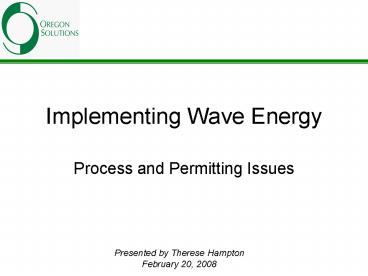Implementing Wave Energy - PowerPoint PPT Presentation
1 / 14
Title:
Implementing Wave Energy
Description:
Our mission is to develop solutions to community based ... Seal/Sea Lion Haul Out. Electromagnetic Fields. General Issues. Decommissioning. Anchor Removal ... – PowerPoint PPT presentation
Number of Views:39
Avg rating:3.0/5.0
Title: Implementing Wave Energy
1
Implementing Wave Energy
- Process and Permitting Issues
Presented by Therese Hampton February 20, 2008
2
Oregon Solutions
- Our mission is to develop solutions to community
based problems that support sustainability
objectives and are built through the
collaborative efforts of business, government and
non-profit organizations. - Problem or Opportunity Defined by the Community
- Governors Designation
- An Oregon Solutions team
- An Integrated Solution
- A Declaration of Cooperation
3
Reedsport as an Oregon Solutions Project
- September 25, 2006Reedsport as Oregon Solutions
Project - The Oregon Solutions team will facilitate a
quicker, more effective application process with
FERC. - Governor Ted Kulongoski
- June 2007 Declaration of Cooperation
- 22 signatories Federal, state and local
organizations - Defined and documented Federal and State
Regulatory Process - Developed a list of issues to be addressed
- Key parties commitment to a settlement process
4
Summary of Stakeholder Issues
- Aquatics Issues
- Whale Entanglement
- Alteration of Marine Habitat
- Seal/Sea Lion Haul Out
- Electromagnetic Fields
- General Issues
- Decommissioning
- Anchor Removal
- Crabbing/Fishing Issues
- Lost Productivity
- Lost gear
- Navigation Safety
- Recreation/Public Safety
- Aesthetics (including lighting)
- Surfing, Whale watching
- System Survivability
5
FERC Licensing Process
- Developed for relicensing of hydro facilities.
- Estimated to be a 5-year process.
- Includes extensive upfront work to agree upon and
conduct studies for potential effect. - Potentially 2 years of study before license
application.
6
Key Differences from Relicensing
- Utility applicant versus new technology
applicants needs. - History of hydro relicensing in the Northwest.
- New versus existing facilities.
- Existing use.
- Location specific application requirement.
7
Applicant is Different
- Traditional Utility
- REVENUE Existing hydro resource is generating
revenue throughout process. - NO RUSH No capital investment or other
implementation costs incurred until new license
is issued. - BELOW MARKET Hydro resource is likely well
below market, even after relicensing. - CAN ABSORB COSTS
- Guaranteed recovery of process costs, assuming
they are reasonable. - Utility has broad resource and customer base to
absorb process and investment costs.
8
Applicant is Different
- New Technology Company
- NO REVENUE No existing facilities to generate
revenue. Company revenue provided by investors. - RUSH Company revenue is dependent on a project
specific Power Purchase Agreement that doesnt
generate revenue until the resource is
operational. - ABOVE MARKET New resource, independent of
process and implementation costs, is likely well
above market. - CANT ABSORB COSTS
- Company is actively investing capital in
technology development. - No guaranteed recovery of process costs. Process
costs will be absorbed into overall cost of
resource, which is already above market. - At this point in development, there is no place
to absorb costs.
9
Applicant is Different
- Impact
- New technology company has a desire for a much
faster pace for settlement and permitting. - New technology company is more cost conscious
relative to studies and operational measures.
10
Recent History in Relicensing
- Many Northwest hydro relicensing projects have
been long and adversarial. The relicensing
process is characterized by - Lack of trust of the applicant
- High process costs
- Extensive studies
- For some, discussion of removal of the project
- Impact
- Applicant is assumed to have utility
characteristics. - The high process costs and extensive studies
impacts the cost-conscious developer. - Discussion of project removal can impact investor
confidence.
11
New versus Existing Facilities
- The current FERC process is premised on
multi-year studies to inform participants prior
to license conditions. - A new facility/technology cannot be studied in
this way - With wave energy, there are no existing
structures to evaluate. - Further, there is very limited empirical data.
- Methods for study arent clear.
- Impact
- Requires qualitative analysis with a
forward-looking view of information needs. - Difficult for resource agencies to make long-term
decision. - Requires a rigorous adaptive management program
to address impacts once study results are known.
12
Existing Use
- Existing ocean use by crabbing and fishing
industry. - Existing ocean use by recreation.
- Impact
- Either opposition to the project or concern about
level of overall development. - Interest in minimizing potential effect to
existing uses.
13
Application is Location Specific
- The FERC permit must be specific about location.
- Further, the FERC permitting process grants
priority to first applicant. - Given the impact to existing industry and
recreation, stakeholders want to have input into
site selection. - Impact
- Encourages filing of preliminary permit to secure
location. - Limits ability to engage collaboratively.
- Tillamook has submitted a permit with multiple
sites
14
Recommendations
- Get to know the community engage with the
locals and know what is important to them. - Be flexible in site location if possible, let
the community play a role in the decision about
where the site will be located. - Support regional environmental analysis the
factors and impacts are fluid. Recognize this
and encourage a process to address the Coastline.
- Partnership Given the uncertainty, expect and
plan to be in an ongoing collaborative process
for many years.































